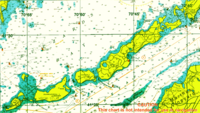Naushon Island
| Geography | |
|---|---|
| Location | Elizabeth Islands |
| Total islands | 1 |
| Area | 7.4 sq mi (19 km2) |
| Administration | |
|
United States
|
|
| State | Massachusetts |
| County | Dukes County |
| Demographics | |
| Population | 30 (2000) |
| The Elizabeth Islands |
|---|
 |
| Major Islands listed in order from east to west |
| Nonamesset Uncatena Naushon Pasque Nashawena Penikese Cuttyhunk |
| Minor Islands: |
| Bachelor Baret Bull Cedar Gosnold Gull Rock Veckatimest Weepecket Islands |
Naushon Island, part of the Elizabeth Islands, is seven miles (11 km) long, just off (SW of) Cape Cod, and four statute miles (6 km) NW of Martha's Vineyard. The island is owned by the Forbes family and is included in the town of Gosnold, Massachusetts. It is the largest of the Elizabeth Islands in land area at 19.18 km² (7.4 sq mi) and had a permanent population of 30 persons as of the 2000 census.
Naushon Island has been a Forbes family retreat for more than a century and a half, since its purchase by John Murray Forbes. Forbes was a businessman who began his career in his family's China trade business (trade which included opium, among other things) and made much of his fortune by investing in the early development of railroads. Naushon Island was purchased by Forbes and a business associate, William W. Swain, in 1842, and Forbes purchased Swain's share soon after to become the sole owner. Upon his death in 1898, Forbes left Naushon in a trust administered by his 5 surviving children and it is now owned by Naushon Island Trust, Inc. Pasque Island and Nashawena Island, the next two islands in the Elizabeth Island chain, were purchased at different times by J. M. Forbes descendants and remain privately owned. There are approximately 35 houses on Naushon, most near the east end.
Naushon Island was at one time the property of James Bowdoin III (1752–1811), son of Massachusetts' governor James Bowdoin II (1726–1790) and appointed by President Thomas Jefferson to serve as the U.S. plenipotentiary to Spain. James III owned a beautiful estate at "Nashaun Island," according to Thomas Bridgman who in 1856 published The Pilgrims of Massachusetts and Their Descendants. Bridgman also notes that Bowdoin was "among the very earliest as well as largest importers of the pure Merino stock and took great pains in improving his own flocks and inculcating the importance of doing so upon others". This interest may have led to the wool sample found among Thomas Jefferson's papers. Jefferson's note reads "Specimen of Mr. Bowdoin's wool, from American sheep raised on his Island of "Nanshaw". The note has been digitized and is available for viewing in the Library of Congress American Memories Collection [1], indexed as "Hackley and Bowdoin, no date, wool samples".
...
Wikipedia
